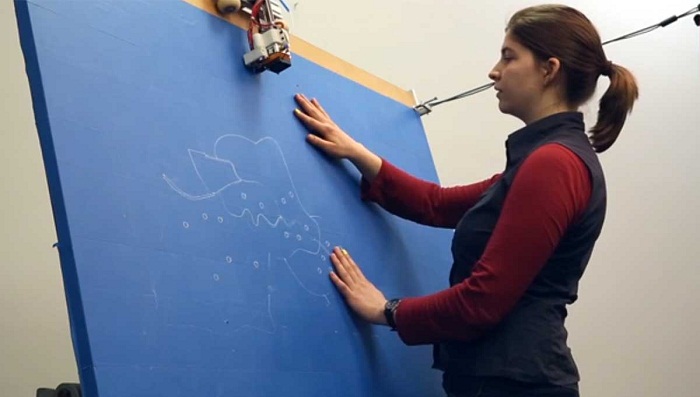3D-printed display lets blind people explore images by touch

The equipment is activated using a pedal and controlled with speech and gestures, allowing users to verbally call up and print images in the form of raised plastic lines. Printed shapes can then be explored by fingertip. The user can request extra detail by pointing to where they want it on the surface, aided by tracking from an overhead depth camera.
“The objective is to let blind users visualise and make sense of complex spatial data just like sighted people,” says Patrick Baudisch, who leads the HPI team. Linespace will be presented at CHI 2016, a computer-human interaction conference in San Jose, California, in May.
Baudisch’s team has written a number of apps for Linespace, including a simplified version of Microsoft Excel for printing large tables and charts, an interior-design package, and a game called Minesweeper.
One app called Homefinder allows people to search for a new apartment on a city map. Users can gesture at areas they want to zoom in on and get a feel for where available, affordable properties are in relation to roads, public transport and shops. If the user wants to input new information, they can use the 3Doodler – a handheld 3D-printing pen – to draw it and the overhead camera will capture it.
Promising vision
Linespace was well-received in tests with six blind and sight-impaired volunteers from varying backgrounds, including a teacher, an artist, a programmer and a social worker. They saw scope for its use in education, for making maps and artwork accessible, and for gaming and sharing information.
But it was the size that grabbed them: “It’s great to have such a big area where we can put information,” said one user, with the ability to print an overview map as well as a piece of zoomed-in detail particularly welcome.
”The possibility of easily creating raised images cheaply and efficiently has so far been elusive – so we are excited about this type of development,” says Steve Tyler at the lab of the Royal National Institute of Blind People (RNIB) in Peterborough, UK. “The ability to easily create diagrammatic, mapping, or more artistic material for a visually impaired creator is potentially phenomenal.”
The RNIB has itself performed experimental work in this area, Tyler says. “The challenge is keeping the technology within financial reach and ensuring ease of use.”
Baudisch estimates that a commercial version of Linespace could cost less than $1000. “We have been debating commercialising it, so it would be good to hear from interested folks,” he says.















































